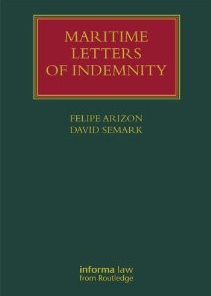 In all honesty, Maritime Letters of Indemnity is not the title of a book I would normally consider reading. I am glad, however, that I was able to have the opportunity to read this book. I preface my review on the fact that I am not well versed in maritime law. While this title has certainly expanded my knowledge level, I can affirmatively say that I have no interest in making the move to the maritime practice area. But If I did, I would buy this book for future reference.
In all honesty, Maritime Letters of Indemnity is not the title of a book I would normally consider reading. I am glad, however, that I was able to have the opportunity to read this book. I preface my review on the fact that I am not well versed in maritime law. While this title has certainly expanded my knowledge level, I can affirmatively say that I have no interest in making the move to the maritime practice area. But If I did, I would buy this book for future reference.
If you practice within the realm of international maritime, and specifically for those who routinely provide representation to shippers, carriers or receivers, this book would make an excellent desk reference. Even if your practice only relates on occasion to shipping and international trade practice, then this book should be a mandatory addition to your library. The authors, Dr. Felipe Arizon and David Semark, have combined a tremendous amount of information to complete this authority on the letter of indemnity.
The book begins by providing an introduction to the letter of indemnity. While the overall subject of maritime letter of indemnity is seemingly a sink or swim topic, the authors do a masterful job of leading the reader into the deep end. Beyond the introduction, the authors do a thorough job of outlining the impact of the use of letters of indemnity by each party making use of bills of lading, namely shippers, receivers, owners and carriers. The authors devote an entire chapter to analyzing the relationship between the various parties and the resulting tension that can arise by the use of a letter of indemnity on that relationship.
Personally, my favorite chapter was an analysis of the Brown Jenkinson decision. The inclusion of passages from the counsel who argued the case provided an opportunity to appreciate the well-spoken barristers of a more formal time, as well as gain understanding of the insight into a case that the authors call “the leading authority on the unenforceability of letters of indemnity issued against clean bills of lading … where the cargo is known by the Master … to be in poor condition on shipment.” The authors’ use of a chapter to analyze Brown Jenkinson provides the opportunity to submit that the industry held an incorrect position following the decision, and thus created a perception that letters of indemnity are unenforceable – a position this book completely dissolves.
The remainder of the book focuses on policy considerations as well as other common letters of indemnity that are encountered. Along the way, the authors attempt to provide clarity to the areas where the law remains unclear, specifically a carrier’s options under a letter of indemnity permitting discharge without the bill of lading. In doing so, the authors reveal drawbacks to the current system and provide input for alternative processes in moving the practice forward.
Overall the book is well drafted. It consists of 166 pages of text and 33 pages of appendix. At nearly $440, the amount of the book seems a little pricey, but for the specialty of the topic and the coverage of the content, it is certainly understandable.
My conclusion after reading Maritime Letters of Indemnity is best summarized in a quote from the text, in which the author opines that the “letter of indemnity is ultimately a document based on little more than trust.” I trust that the authors have provided an in depth coverage of the topic, but ultimately my expedition into maritime law and letters of indemnity would leave the shipping community “… seriously exposed.”
* Affiliate Link
Editor’s note: This review was done by Alan Duke, one of my law partners. Given his technical background in engineering and construction, I felt he was better suited to reviewing this book.













